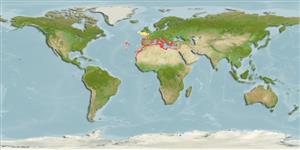>
Scombriformes (Mackerels) >
Centrolophidae (Medusafishes)
Etymology: Schedophilus: Name from Greek words 'phylos' (Φίλος), t) meaning 'one who likes' and "s 'shedia' (Σχεδία) which means raft; literally means 'the one who likes rafts'. This probably refers to the lifestyle ot the juveniles of this genus (Michail Ragousis, mar10091@marine.aegean.gr, pers. Comm. 01/16) which are epipelagic and associate with floating jellyfish.
More on author: Cuvier.
Environment: milieu / climate zone / depth range / distribution range
Ecologia
marino benthopelagico; distribuzione batimetrica 70 - 700 m (Ref. 52180). Subtropical; 52°N - 16°S, 65°W - 36°E
Eastern Atlantic: Spain and throughout most of the Mediterranean southward. Although reported to occur in South Africa (Ref. 4542, 6942), Smith 1995 (Ref. 11228) mentions that the species occurring in southern Africa is not Schedophilus ovalis but Schedophilus velaini. Western Central Atlantic: a small specimen recorded from Bermuda.
Size / Peso / Age
Maturity: Lm ? range ? - ? cm
Max length : 100.0 cm TL maschio/sesso non determinato; (Ref. 3596); common length : 60.0 cm TL maschio/sesso non determinato; (Ref. 3596)
Prefers deep water at the edge of continental shelves and around oceanic islands; larger specimens near the bottom (Ref. 4542). Young are epipelagic and associate with floating jellyfish, including Physalia (Ref. 4542). Adults are caught on hooks baited with fish or squid. Its white flesh is reported to be good-tasting (Ref. 4542).
Life cycle and mating behavior
Maturità | Riproduzione | Deposizione | Uova | Fecundity | Larve
Haedrich, R.L., 1990. Centrolophidae. p. 1011-1013. In J.C. Quero, J.C. Hureau, C. Karrer, A. Post and L. Saldanha (eds.) Check-list of the fishes of the eastern tropical Atlantic (CLOFETA). JNICT, Lisbon; SEI, Paris; and UNESCO, Paris. Vol. 2. (Ref. 6942)
IUCN Red List Status (Ref. 130435: Version 2024-1)
Threat to humans
Harmless
Human uses
Pesca: commerciale
Strumenti
Special reports
Download XML
Fonti Internet
Estimates based on models
Preferred temperature (Ref.
123201): 11.8 - 18.8, mean 14.8 °C (based on 221 cells).
Phylogenetic diversity index (Ref.
82804): PD
50 = 0.5039 [Uniqueness, from 0.5 = low to 2.0 = high].
Bayesian length-weight: a=0.00832 (0.00410 - 0.01689), b=3.10 (2.91 - 3.29), in cm total length, based on LWR estimates for this species & (Sub)family-body (Ref.
93245).
Trophic level (Ref.
69278): 3.5 ±0.47 se; based on food items.
Resilienza (Ref.
120179): Basso, tempo minimo di raddoppiamento della popolazione 4.5 - 14 anni (Preliminary K or Fecundity.).
Fishing Vulnerability (Ref.
59153): High vulnerability (60 of 100).
Climate Vulnerability (Ref.
125649): Moderate vulnerability (39 of 100).
Nutrients (Ref.
124155): Calcium = 28.7 [14.5, 52.1] mg/100g; Iron = 0.619 [0.372, 1.095] mg/100g; Protein = 18 [16, 20] %; Omega3 = 0.279 [0.157, 0.489] g/100g; Selenium = 58.3 [26.8, 121.8] μg/100g; VitaminA = 7.9 [2.0, 32.3] μg/100g; Zinc = 0.544 [0.377, 0.841] mg/100g (wet weight);
